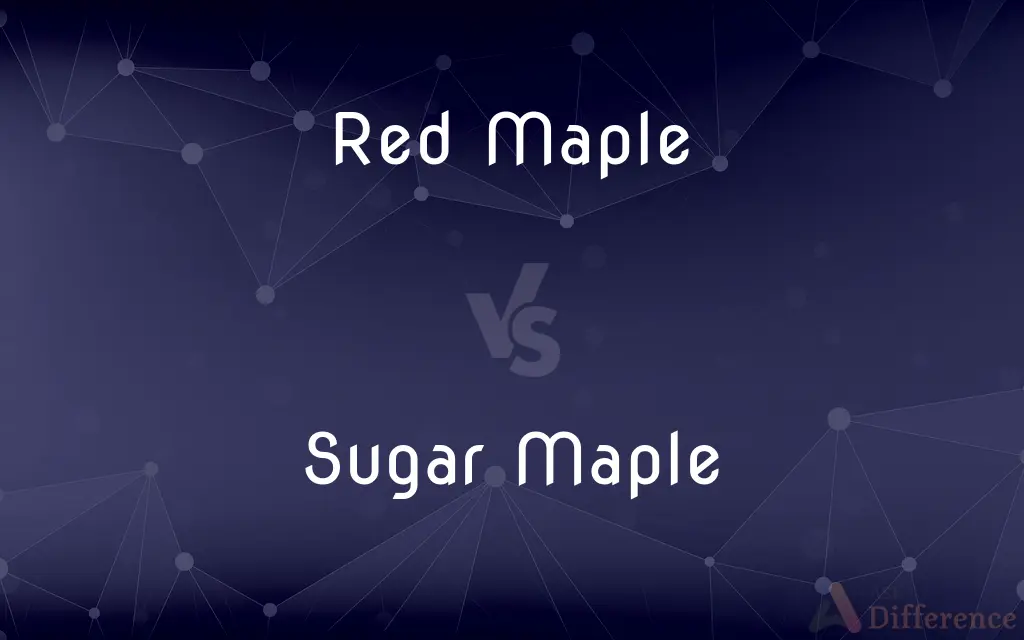Red Maple vs. Sugar Maple — What's the Difference?
By Tayyaba Rehman — Published on December 17, 2023
Red Maple has red twigs and grows in varied soils, while Sugar Maple is known for its sap and thrives in deep, well-drained soils.

Difference Between Red Maple and Sugar Maple
Table of Contents
ADVERTISEMENT
Key Differences
Red Maple and Sugar Maple are both deciduous trees commonly found in North America. Red Maple, as its name implies, often showcases reddish hues in its twigs, buds, and autumn leaves. Sugar Maple, on the other hand, is renowned for its brightly colored fall foliage and the sap from which maple syrup is derived.
Both trees play significant roles in ecosystems and landscaping. Red Maple adapts easily to a variety of soil types and conditions, making it a frequent choice for urban planting. Sugar Maple, with its dense and hard wood, is valuable for timber and is the primary source of maple syrup, given its high sap sugar content.
The leaves of these maples differ too. Red Maple leaves have serrated edges and are usually 3-5 lobed, with a whitish underside. Sugar Maple leaves are more distinct, typically having 5 lobes without serrated edges, and they turn vibrant shades of yellow, orange, or red in the fall.
In terms of growth habitats, Red Maple often thrives in moist sites and can be found near streams or wetlands. Sugar Maple, contrastingly, prefers well-drained, fertile soils, often found in upland areas or hill slopes.
While both trees contribute to the beauty of fall landscapes, their uses and characteristics set them apart. The Red Maple's versatility and adaptability make it a favorite for many environments, while the Sugar Maple's sap and brilliant fall colors have made it an iconic tree in North America.
ADVERTISEMENT
Comparison Chart
Color Attributes
Red twigs, buds, and fall leaves
Vibrant yellow, orange, or red fall leaves
Soil Preference
Adaptable, varied soils
Deep, well-drained, fertile soils
Leaf Description
Serrated edges, 3-5 lobes, whitish underside
Smooth edges, 5 lobes
Primary Use
Landscaping, adaptable to urban settings
Timber, sap for maple syrup
Growth Habitats
Often near streams or wetlands
Upland areas, hill slopes
Compare with Definitions
Red Maple
A North American maple tree with red twigs and buds.
The Red Maple stood out with its fiery autumn foliage.
Sugar Maple
Wood is dense and hard, suitable for timber.
The Sugar Maple was often used for quality furniture.
Red Maple
Commonly found near wetlands or streams.
A line of Red Maples grew by the riverbank.
Sugar Maple
Features leaves with smooth edges and 5 lobes.
The Sugar Maple's leaves created a vibrant fall display.
Red Maple
Adaptable to various soil types.
They planted a Red Maple in the urban park due to its resilience.
Sugar Maple
Iconic tree of the northeastern U.S.
Vermont's fall landscape was dotted with Sugar Maples.
Red Maple
Leaves typically have 3-5 lobes with serrated edges.
The Red Maple's leaves turned a shade of crimson in the fall.
Sugar Maple
A deciduous tree valued for its sap.
They tapped the Sugar Maple in spring to make syrup.
Red Maple
Provides habitat and food for various wildlife.
Birds often nested in the branches of the Red Maple.
Sugar Maple
Prefers fertile, well-drained soils.
The Sugar Maple grove on the hill was a local attraction.
Sugar Maple
Alternative spelling of sugar maple
Common Curiosities
Are the seeds of both trees similar?
Both trees produce winged seeds called samaras, but their sizes and shapes can vary.
Can the Red Maple grow in wet areas?
Yes, the Red Maple often thrives near wetlands or streams.
What colors can the Sugar Maple leaves turn in the fall?
Sugar Maple leaves can turn yellow, orange, or bright red in the fall.
Which tree grows faster, the Red Maple or Sugar Maple?
The Red Maple typically grows faster than the Sugar Maple.
Is the Red Maple's wood as valuable as the Sugar Maple's?
While both are used in woodworking, Sugar Maple's dense, hard wood is especially valued for furniture and flooring.
Can Red Maple leaves also turn colors other than red in the fall?
Yes, while often red, Red Maple leaves can also turn yellow or orange in the fall.
Are both trees native to North America?
Yes, both Red Maple and Sugar Maple are native to North America.
Which tree is more commonly tapped for syrup, Red Maple or Sugar Maple?
The Sugar Maple is the primary tree tapped for maple syrup due to its high sap sugar content.
Are there syrup varieties made from Red Maple sap?
Yes, while less common than Sugar Maple syrup, Red Maple can also be tapped for syrup.
How can I distinguish the leaves of the two trees?
Red Maple leaves have serrated edges and 3-5 lobes, while Sugar Maple leaves have smooth edges with 5 lobes.
Share Your Discovery

Previous Comparison
Herbs vs. Trees
Next Comparison
Maternal Twins vs. Paternal TwinsAuthor Spotlight
Written by
Tayyaba RehmanTayyaba Rehman is a distinguished writer, currently serving as a primary contributor to askdifference.com. As a researcher in semantics and etymology, Tayyaba's passion for the complexity of languages and their distinctions has found a perfect home on the platform. Tayyaba delves into the intricacies of language, distinguishing between commonly confused words and phrases, thereby providing clarity for readers worldwide.












































